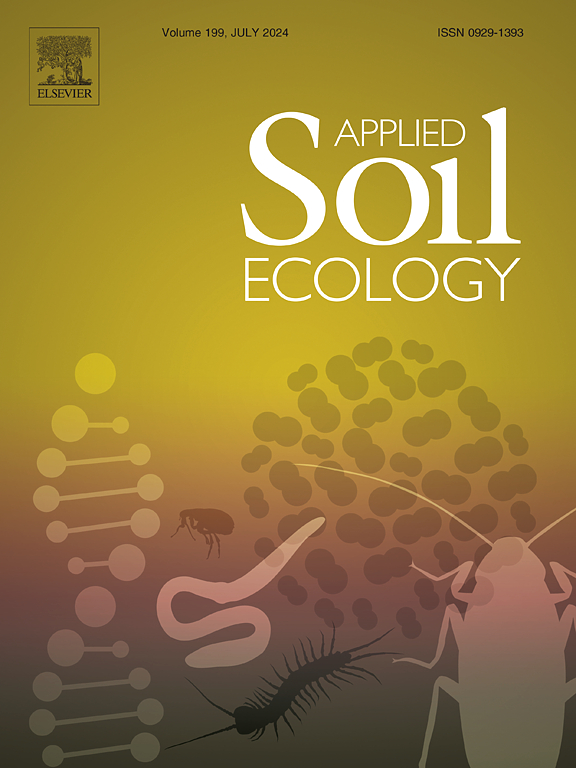结构复杂性增强对德国森林土壤微生物特性的短期影响不一致
IF 5
2区 农林科学
Q1 SOIL SCIENCE
引用次数: 0
摘要
结构和生物同质化可能是由于缺乏促进林冠间隙和枯木的林业实践造成的。这可能导致生物多样性丧失和生态系统功能受损。提高结构复杂性(ESC)已被提出来抵消这些影响,但其对土壤性质的影响仍未充分了解。总的来说,我们假设ESC增强了土壤的非生物特性、空间变异性和微生物功能,其影响受环境背景的调节,并随着时间的推移而增加。数据来自德国8个山毛榉林的148个斑块(50 × 50 m)。在一半的斑块中,通过两种空间模式——聚集(一个大空隙)和分布(小空隙)——以及留下或移除枯木(树桩、原木、障碍),砍伐了30%的活树基部面积,从而提高了结构的复杂性。另一半作为对照,代表管理的、同质的生产森林。枯木附近土壤碳(C) %、氮(N) %和碳氮比增加。8个样地中有3个样地土壤微生物生物量和活性受到显著影响,影响幅度在- 30%到+ 62%之间。较高的土壤含水量与增加的微生物生物量相关,而较大的林下生物量与较低的微生物呼吸商相关。但是,没有观察到五年内的时间趋势。尽管土壤特性显示出对结构干预的抗性,但地点特异性效应强调了土壤湿度和下层植被对微生物功能的重要性。需要在我们的研究结果的基础上进行进一步的研究,以制定切实可行的森林管理战略,以阐明结构复杂性如何支持土壤功能和生态系统恢复力。本文章由计算机程序翻译,如有差异,请以英文原文为准。

Inconsistent short-term effects of enhanced structural complexity on soil microbial properties across German forests
Structural and biotic homogenization can result from forestry practices lacking promotion of canopy gaps and deadwood. This can lead to biodiversity loss and impaired ecosystem functions. Enhancing structural complexity (ESC) has been proposed to counteract these effects, but its impact on soil properties remains insufficiently understood. Overall, we hypothesize that ESC enhances soil abiotic properties, their spatial variability, and microbial functioning, with effects modulated by environmental context and increasing over time. Data were collected from 148 patches (50 × 50 m) in eight beech forests across Germany. In half of the patches, structural complexity was enhanced by felling 30 % of the basal area of living trees through two spatial patterns—aggregated (one large gap) and distributed (small gaps)—combined with leaving or removing deadwood (stumps, logs, snags). The other half served as controls, representing managed, homogeneous production forests. Soil carbon (C) %, nitrogen (N) %, and C:N ratio increased near deadwood. Soil microbial biomass and activity were significantly affected in three of eight forest sites, effects ranging from −30 % to +62 %. Higher soil water content was associated with increased microbial biomass, and greater understorey biomass correlated with a lower microbial respiratory quotient. However, no temporal trends were observed over five years. Although soil properties showed resistance to structural interventions, site-specific effects underline the importance of soil moisture and the understorey vegetation for microbial functioning. Further research building on our results is needed to develop practical forest management strategies to clarify how structural complexity may support soil functioning and ecosystem resilience.
求助全文
通过发布文献求助,成功后即可免费获取论文全文。
去求助
来源期刊

Applied Soil Ecology
农林科学-土壤科学
CiteScore
9.70
自引率
4.20%
发文量
363
审稿时长
5.3 months
期刊介绍:
Applied Soil Ecology addresses the role of soil organisms and their interactions in relation to: sustainability and productivity, nutrient cycling and other soil processes, the maintenance of soil functions, the impact of human activities on soil ecosystems and bio(techno)logical control of soil-inhabiting pests, diseases and weeds.
 求助内容:
求助内容: 应助结果提醒方式:
应助结果提醒方式:


